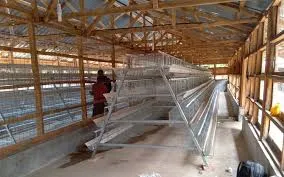Affordable Layer Chicken Cages Available for Purchase Now
Dec . 19, 2024 10:14 Back to list
Affordable Layer Chicken Cages Available for Purchase Now
Invest in Layer Chicken Cages for Enhanced Poultry Productivity
In the modern poultry industry, efficiency and productivity are paramount. One of the most significant ways to achieve this is through the use of layer chicken cages. These specialized enclosures are designed to provide optimal living conditions for hens, thereby maximizing egg production while ensuring their health and well-being. For poultry farmers looking to scale up operations, investing in layer chicken cages for sale can be a game-changer.
Understanding Layer Chicken Cages
Layer chicken cages are engineered systems that house hens in a multi-tiered structure. This design allows farmers to make the most of their space by stacking multiple layers of cages vertically. Each cage is equipped with feeding troughs, watering systems, and sometimes even automated egg collection systems. The primary benefit of this system is that it accommodates a larger number of birds in a smaller area, thereby increasing overall productivity without the need for additional land.
Benefits of Layer Chicken Cages
1. Space Efficiency Traditional floor systems require significantly more land. Layer cages utilize vertical space, which is particularly advantageous for farmers with limited acreage. This space efficiency means more hens can be housed in the same area, resulting in higher egg production rates.
2. Improved Hygiene and Health Layer chicken cages are easier to clean compared to conventional systems. A cleaner environment reduces the risk of diseases, which can devastate poultry populations. Automated cleaning systems can further enhance hygiene and reduce the labor involved in maintaining clean living conditions for the hens.
3. Enhanced Egg Production Research shows that hens in well-designed cages often lay more eggs than their counterparts in free-range or barn systems. This increase can be attributed to better management of their feeding, watering, and lighting conditions—all crucial factors for optimal laying performance.
4. Optimal Conditions Layer cages are engineered to provide the ideal environment for hens. This includes controlled temperatures, ventilation, and light exposure, all of which contribute to the hens' comfort and productivity. In contrast, birds in free-range systems can face environmental stressors that negatively influence their egg-laying capabilities.
5. Reduced Feed Waste Feed is one of the largest expenses in poultry farming, and layer cages help minimize waste. With designated feeding systems, hens have less opportunity to scatter feed, ensuring that more of it is consumed, which can contribute to better growth and egg production rates.
layer chicken cages for sale

Options for Layer Chicken Cages
When considering layer chicken cages for sale, farmers have numerous options to choose from. These can range from simple, manual systems to highly automated solutions that integrate advanced technology. Some cages offer features like automatic egg collection and climate control systems, which can further optimize production and reduce labor costs.
Factors to Consider
Before purchasing layer chicken cages, it’s essential for farmers to consider a few key factors
1. Quality and Durability Investing in high-quality cages is crucial. Look for materials that are resistant to corrosion and wear, as well as good ventilation systems that maintain a healthy environment for the hens.
2. Compliance with Regulations Ensure that the cages meet local animal welfare regulations. Modern farming practices increasingly focus on the humane treatment of animals, so it’s vital to choose cages that provide adequate space and comfort for the hens.
3. Cost vs. Benefit While investing in layer chicken cages can be significant, it’s essential to weigh the initial costs against the long-term benefits of increased productivity and efficiency.
Conclusion
Investing in layer chicken cages is a crucial step for poultry farmers aiming to enhance their operations. The benefits of these systems—space efficiency, improved hygiene, and higher egg production rates—make them a vital component of successful poultry farming. With a careful selection process and consideration of factors like quality and compliance, farmers can significantly boost their productivity and, ultimately, their profitability. As the poultry industry continues to evolve, layer chicken cages will play an increasingly central role in meeting global food demands.
-
Hot Sale 24 & 18 Door Rabbit Cages - Premium Breeding Solutions
NewsJul.25,2025
-
Automatic Feeding Line System Pan Feeder Nipple Drinker - Anping County Yize Metal Products Co., Ltd.
NewsJul.21,2025
-
Automatic Feeding Line System Pan Feeder Nipple Drinker - Anping County Yize Metal Products Co., Ltd.
NewsJul.21,2025
-
Automatic Feeding Line System - Anping Yize | Precision & Nipple
NewsJul.21,2025
-
Automatic Feeding Line System - Anping Yize | Precision & Nipple
NewsJul.21,2025
-
Automatic Feeding Line System-Anping County Yize Metal Products Co., Ltd.|Efficient Feed Distribution&Customized Animal Farming Solutions
NewsJul.21,2025






